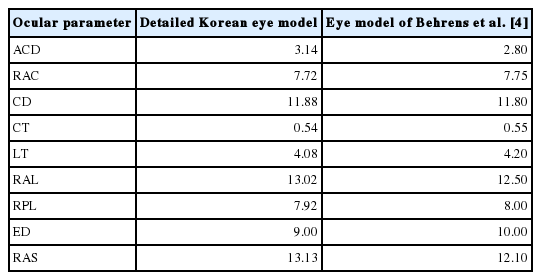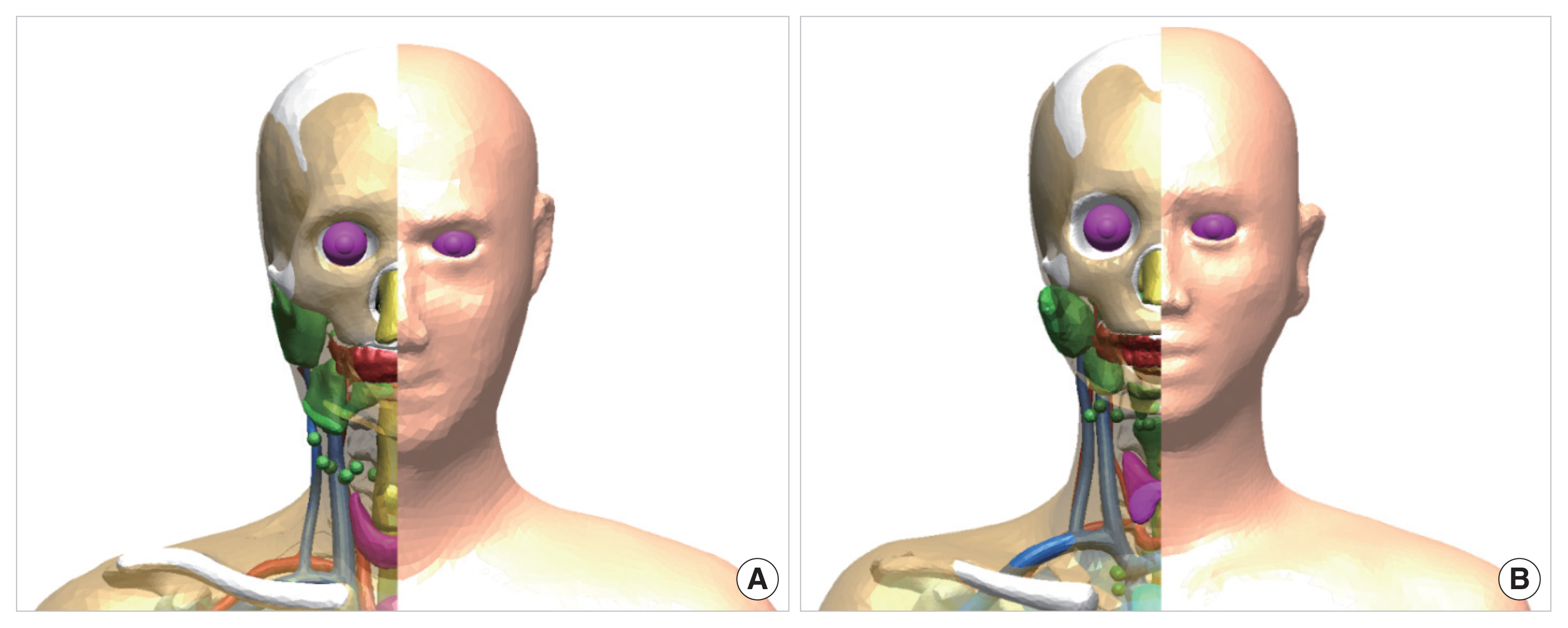Development of Detailed Korean Adult Eye Model for Lens Dose Calculation
Article information
Abstract
Background
Recently, the International Commission on Radiological Protection (ICRP) lowered the dose limit for the eye lens from 150 mSv to 20 mSv, highlighting the importance of accurate lens dose estimation. The ICRP reference computational phantoms used for lens dose calculation are mostly based on the data of Caucasian population, and thus might be inappropriate for Korean population.
Materials and Methods
In the present study, a detailed Korean eye model was constructed by determining nine ocular dimensions using the data of Korean subjects. The developed eye model was then incorporated into the adult male and female mesh-type reference Korean phantoms (MRKPs), which were then used to calculate lens doses for photons and electrons in idealized irradiation geometries. The calculated lens doses were finally compared with those calculated with the ICRP mesh-type reference computational phantoms (MRCPs) to observe the effect of ethnic difference on lens dose.
Results and Discussion
The lens doses calculated with the MRKPs and the MRCPs were not much different for photons for the entire energy range considered in the present study. For electrons, the differences were generally small, but exceptionally large differences were found at a specific energy range (0.5–1 MeV), the maximum differences being about 10 times at 0.6 MeV in the anteroposterior geometry; the differences are mainly due to the difference in the depth of the lens between the MRCPs and the MRKPs.
Conclusion
The MRCPs are generally considered acceptable for lens dose calculations for Korean population, except for the electrons at the energy range of 0.5–1 MeV for which it is suggested to use the MRKPs incorporating the Korean eye model developed in the present study.
Introduction
In 2012, the International Commission on Radiological Protection (ICRP) suggested a new threshold dose of 0.5 Gy for radiation-induced cataracts for both acute and fractionated irradiation, according to the new findings which suggested that the lens of the eye may be more radiosensitive than previously considered [1]. Consequently, the occupational annual equivalent dose limit for the lens of the eye was reduced from 150 mSv to 20 mSv, averaged over 5 years, without a single year exceeding 50 mSv, highlighting the importance of the accurate estimation of the lens dose.
The current ICRP reference lens dose coefficients (DCs) provided in ICRP Publication 116 [2] were calculated generally by using the ICRP voxel-type reference computational phantoms described in ICRP Publication 110 [3], just as the DCs for the other organs. However, for weakly-penetrating radiations showing a steep dose gradient, these phantoms were considered inappropriate due to the low voxel resolutions (2.137×2.137×8 mm3 for male and 1.775×1.775×4.84 mm3 for female) to represent the eye structures; the detailed eye model developed by Behrens et al. [4] was thus additionally adopted and used for the calculations of the lens doses to such weakly-penetrating radiations. The detailed eye model was constructed as a mathematical (stylized) model, which well represents the spherical structure of the eyes. However, due to its model type (stylized model), it had to be incorporated into a stylized head phantom [5], instead of ICRP-110 voxel-type phantoms.
Since 2016, a project by ICRP Task Group 103 has been underway to convert the ICRP voxel-type reference phantoms into a high-quality/fidelity mesh format to address the limitations due to the nature of voxel structure (i.e., stair-stepped surface and holes in wall organs/tissues) [6]. Recently, the ICRP mesh-type reference computational phantoms (MRCPs) for adult male and female were completed, which include all organs and tissues, even including very thin radiosensitive layers, required for effective dose calculations, while maintaining the topology of the ICRP-110 phantoms. For the eye of the MRCPs, the detailed eye model of Behrens et al. [4] was directly installed by converting the stylized eye model into the mesh format [7]. The lens DCs were then re-calculated by using the adult MRCPs [8, 9], which showed significant differences from the ICRP-116 lens DCs.
However, the detailed eye model of Behrens et al. [4], as well as the MRCPs, are mostly based on the data of Caucasian population, and thus they might be inappropriate for Korean population. The International Atomic Energy Agency (IAEA) recommended Asian countries to use specific national reference values for radiological protection programs, describing generally large variances in anthropometric parameters among national populations [10]. Therefore, in the present study, detailed Korean eye model was developed based on the data of Korean ocular dimensions, using the same approach used in Behrens et al. [4]. The developed eye model was incorporated into the mesh-type reference Korean phantoms (MRKPs) [11], which were recently developed with comparable quality to the MRCPs, based on Korean anatomical reference data for adults established by Choi et al. [12]. Then the lens doses were calculated for photons in six irradiation geometries—i.e., anteroposterior (AP), posteroanterior (PA), right lateral (RLAT), left lateral (LLAT), rotational (ROT), and isotropic (ISO)—and electrons in three irradiation geometries (i.e., AP, PA, and ISO), both for the energy range of 0.01–10,000 MeV. The calculated values were compared with the lens doses calculated by using the MRCPs to observe the effect of ethnic difference on lens doses.
Materials and Methods
1. Development of Detailed Korean Eye Model
Following the approach used in Behrens et al. [4], the detailed Korean eye model was developed based on nine ocular parameters [13] as follows: (1) anterior chamber depth along the optical axis (ACD); (2) radius of curvature of the anterior surface of the cornea (RAC); (3) corneal diameter (CD); (4) corneal thickness along the optical axis (CT); (5) lens thickness along the optical axis (LT); (6) radius of curvature of the anterior surface of the lens (RAL); (7) radius of curvature of the posterior surface of the lens (RPL); (8) equatorial diameter of the lens (ED); and (9) radius of curvature of the anterior surface of the sclera (RAS).
Fig. 1 indicates the measurement locations for the listed nine parameters. The values of these parameters for the Korean eye model were determined by using the data given in scientific literatures [14–17] which measured the ocular parameters in Korean adult subjects and Korean reference eye mass given in Choi et al. [12]. The priority order of the data used for the determination of the nine parameters is summarized in Table 1.
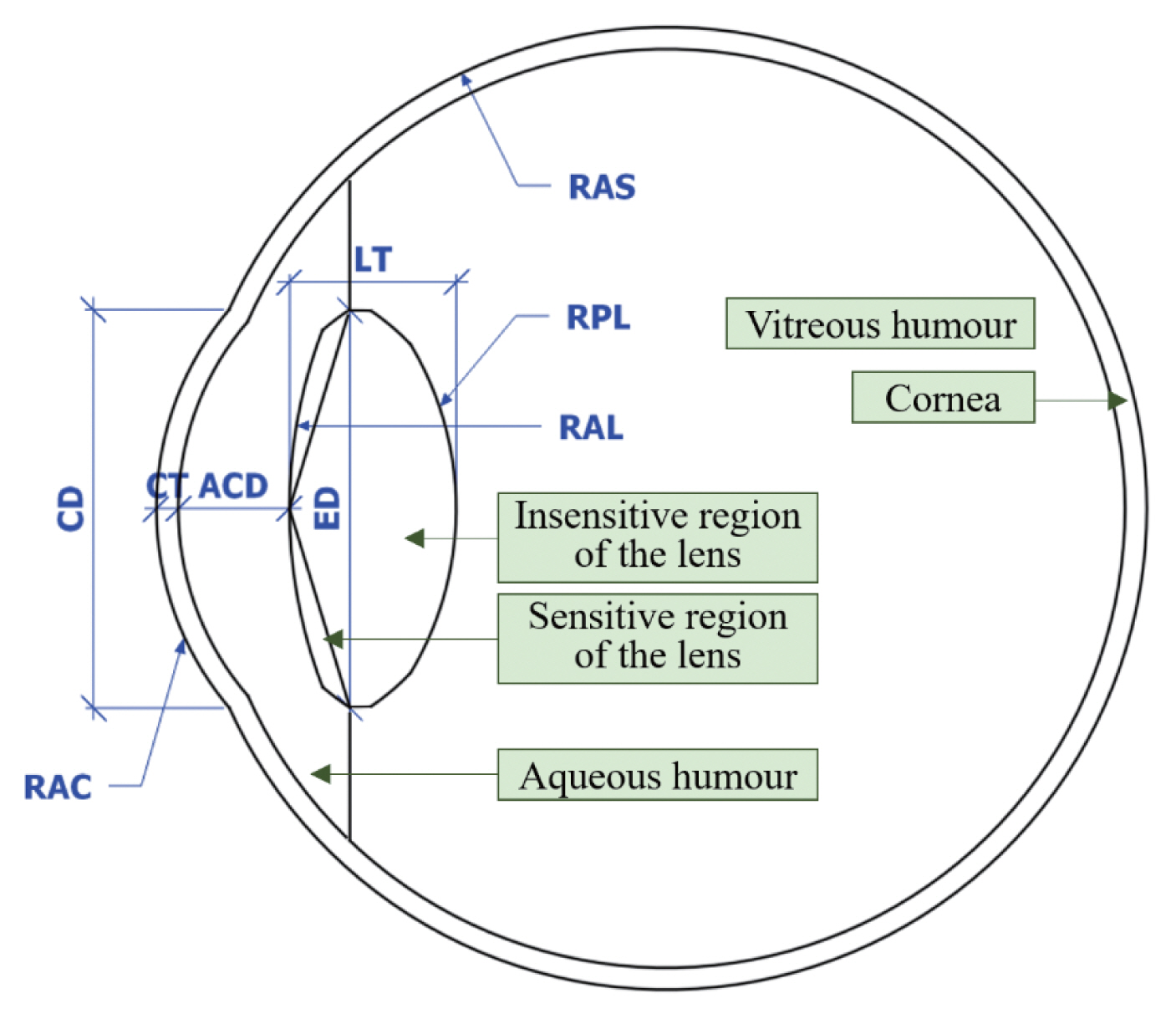
Nine ocular parameters and five ocular tissues defined in detailed Korean eye model. ACD, anterior chamber depth; RAC, radius of curvature of anterior cornea; CD, corneal diameter; CT, corneal thickness; LT, lens thickness; RAL, radius of curvature of anterior lens; RPL, radius of curvature of posterior lens; ED, equatorial diameter; RAS, radius of curvature of anterior sclera.
Firstly, ACD, RAC, and CD were determined from the data given in Lee et al. [14], which measured the ocular parameters from the largest number (i.e., 314) of subjects. Among these three parameters, ACD, which showed apparent correlations to age [14], was exceptionally determined as an age group specific population-weighted mean value by using the recent Korean population census data investigated in January 2020 by Statistics Korea (https://kostat.go.kr/). For this case, the data for the ages between 20 and 50 were exclusively considered for the consistency with the “adult” in ICRP Publication 89 [18]. Note that it was confirmed by the author that the ACD values given in Lee et al. [14] were assumed as the dimension measured from the anterior corneal surface to anterior lens surface, i.e., the sum of CT and ACD. RAC and CD, of which variation with age is negligible [14], were simply determined as the overall mean values. For conversion of the dioptric power of cornea to CT, the Equation (1) given in Olsen [19] was used:
CT, LT, RAL, and RPL, which were not provided in Lee et al. [14], were determined from data measured in other studies [15–17] conducted on Korean eyes. For the determination of LT which increases during adult ages, an age group specific population-weighted mean for the ages between 20 and 50 was calculated by using the data given in Lim et al. [16] and Korean census data, just as ACD. CT and radii of curvature of the lens (i.e., RAL and RPL) were determined from Kim et al. [17] and Park et al. [15], respectively. Note that each of the parameters were determined from the data given in a single reference, to avoid the likely redundancy of the measured subjects.
ED was inevitably determined as the ED value used for the construction of Chinese eye model [20] due to the lack of in vivo measured data for Korean eyes. Finally, RAS was automatically decided as the value to match the total reference mass for Korean eyes.
Following the approach used in Behrens et al. [4], the detailed Korean eye model was subdivided into five regions, i.e., lens (sensitive and insensitive regions), aqueous humour, vitreous humour, and cornea, as indicated in Fig. 1. Note that the sensitive region of the lens was defined to represent the significant volume of the lens stated in ICRP recommendations [21], as was done in Behrens et al. [4]. The elemental compositions and densities for each region was adopted from Choi et al. [11].
2. Incorporation of Eye Model into Mesh-Type Reference Korean Phantoms
The developed Korean detailed eye model was incorporated into the adult male and female MRKPs [11], by adopting the approach used for the incorporation of detailed eye model of Behrens et al. [4] into the MRCPs [7]. The developed detailed eye model was first constructed in the non-uniform rational B-spline (NURBS) format using Rhinoceros 5.0 software (Robert McNeel & Associates, Seattle, WA, USA) and was exported as mesh format. Then, by using Rapidform software (INUS Technology Inc., Seoul, Korea), the defects in the mesh model (e.g., self-intersection, abnormal facets) were eliminated. The refined polygon mesh model was installed in the MRKPs, matching the center of the eye model to the orbital center of the cranium. The MRKPs with the newly incorporated eye model were finally converted into tetrahedral mesh by using the TetGen code [22] for the enhanced computational speed of Monte Carlo dose calculation in Geant4 [23].
3. Calculation of Lens Doses
Lens doses per particle fluence (i.e., fluence-to-effective dose conversion coefficients) were calculated by using the developed detailed Korean eye model incorporated into the MRKPs. Lens doses were calculated for photons in the energy range of 0.01–10,000 MeV in six irradiation geometries (i.e., AP, PA, RLAT, LLAT, ROT, ISO) and electrons in the energy range of 0.01–10,000 MeV in three irradiation geometries (i.e., AP, PA, and ISO). For dose calculation, the tetrahedralized MRKPs were implemented in Geant4 toolkit (version 10.04) [23] by using the G4Tet and G4Parameterisation classes. The physics library of G4EMLivermorePhysics was used, and a secondary range cut value of 1 μm was applied, considering the micrometer-scaled structure of the detailed eye model. The number of primary particles was set to keep the statistical relative error of the calculated lens doses below 5%. In addition, to observe the effects of ethnic difference on lens doses, the calculated lens doses were compared with the lens doses calculated by using the MRCPs.
Results and Discussion
1. Detailed Korean Eye Model
Table 2 shows the nine ocular parameters determined for the detailed Korean eye model along with those for the eye model of Behrens et al. [4]. The differences between two eye models are generally within 10%, except for ACD which is indeed the most important parameter in lens dose calculation in that it dominantly decides the depth of the lens from the external corneal surface.
Fig. 2 shows the detailed Korean eye model constructed as a stylized model using the nine ocular parameters determined in the present study, and that converted into the mesh-format for incorporation into the MRKPs. It can be seen that the eye model in the mesh format well represents the five ocular tissues (i.e., sensitive/insensitive regions of the eye lens, aqueous humour, vitreous humour, and cornea). The eye model in the mesh-format was constructed with a large number of facets (approx. 40,000) to preserve the shape of the stylized model, and as shown in Table 3, the changes in the ocular tissue masses during the conversion were all within 0.1%. Finally, Fig. 3 shows the detailed Korean eye model incorporated into the adult male and female MRKPs.
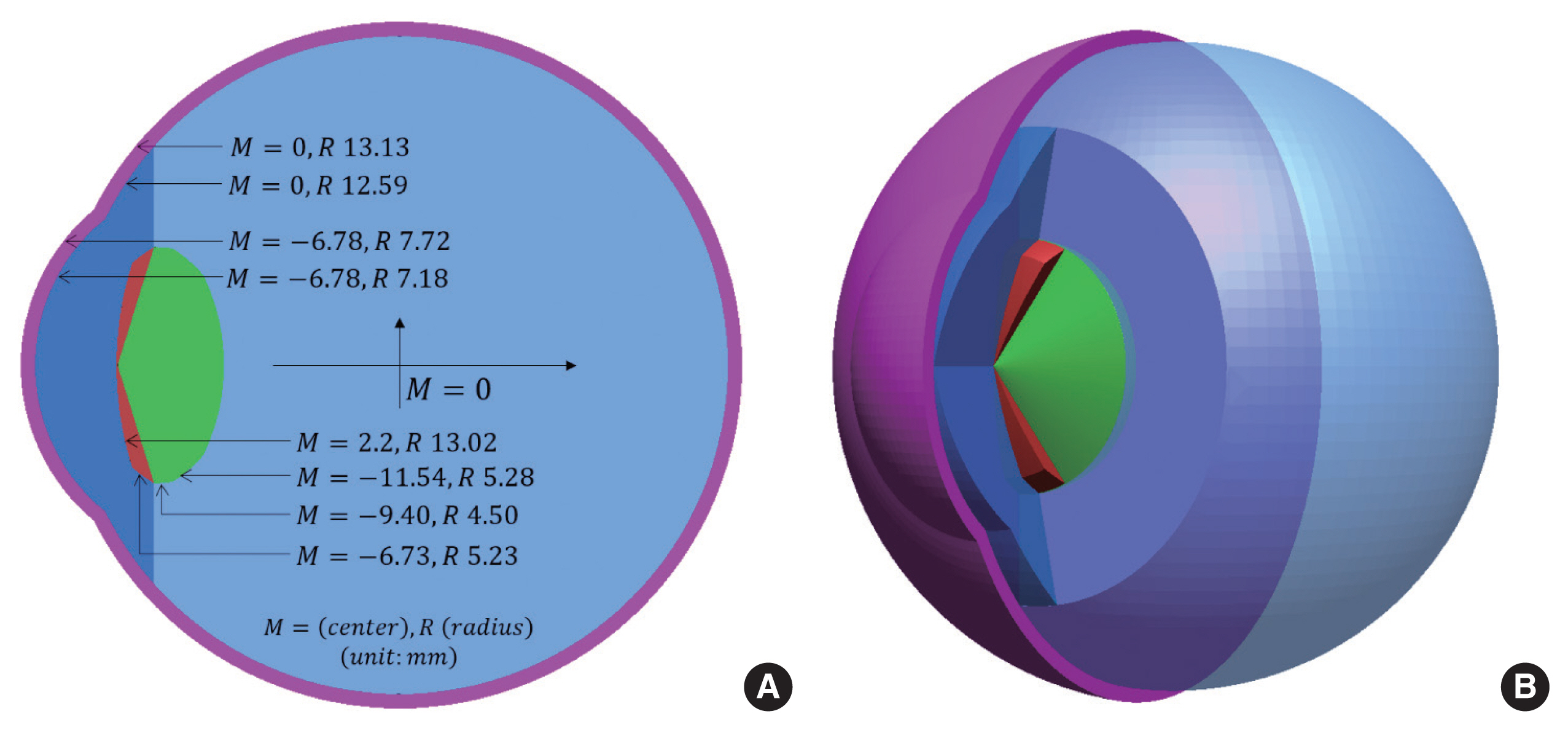
Detailed Korean eye model constructed in stylized model (A) and that converted into mesh-format (B).
2. Lens Doses
Fig. 4 compares the lens doses of the entire lens per particle fluence for photons in five idealized irradiation geometries—i.e., AP, PA, LAT (averaged value of the doses for RLAT and LLAT), ROT, and ISO—calculated with the MRKPs and the MRCPs, where the detailed Korean eye model and the eye model by Behrens et al. [4] were installed, respectively. In the AP, PA, ROT, and LAT geometries, for most of the energies higher than 0.05 MeV, the lens doses calculated with MRKPs were not much different when compared with those calculated with the MRCPs, generally showing the differences within 15%. For very low energies, however, the lens doses of the MRKPs were significantly lower, the maximum difference being a factor of about two, which is mainly due to the deeper lens depth (greater ACD and smaller ED values) in the MRKPs. The similar trend was found in the ISO geometry, except for very high-energy photons (i.e., >100 MeV), where the lens doses in the MRKPs were greater by up to 43%. This relatively large difference is related with the difference in the size/shape of the head and the relative location of the eyes in the cranium.
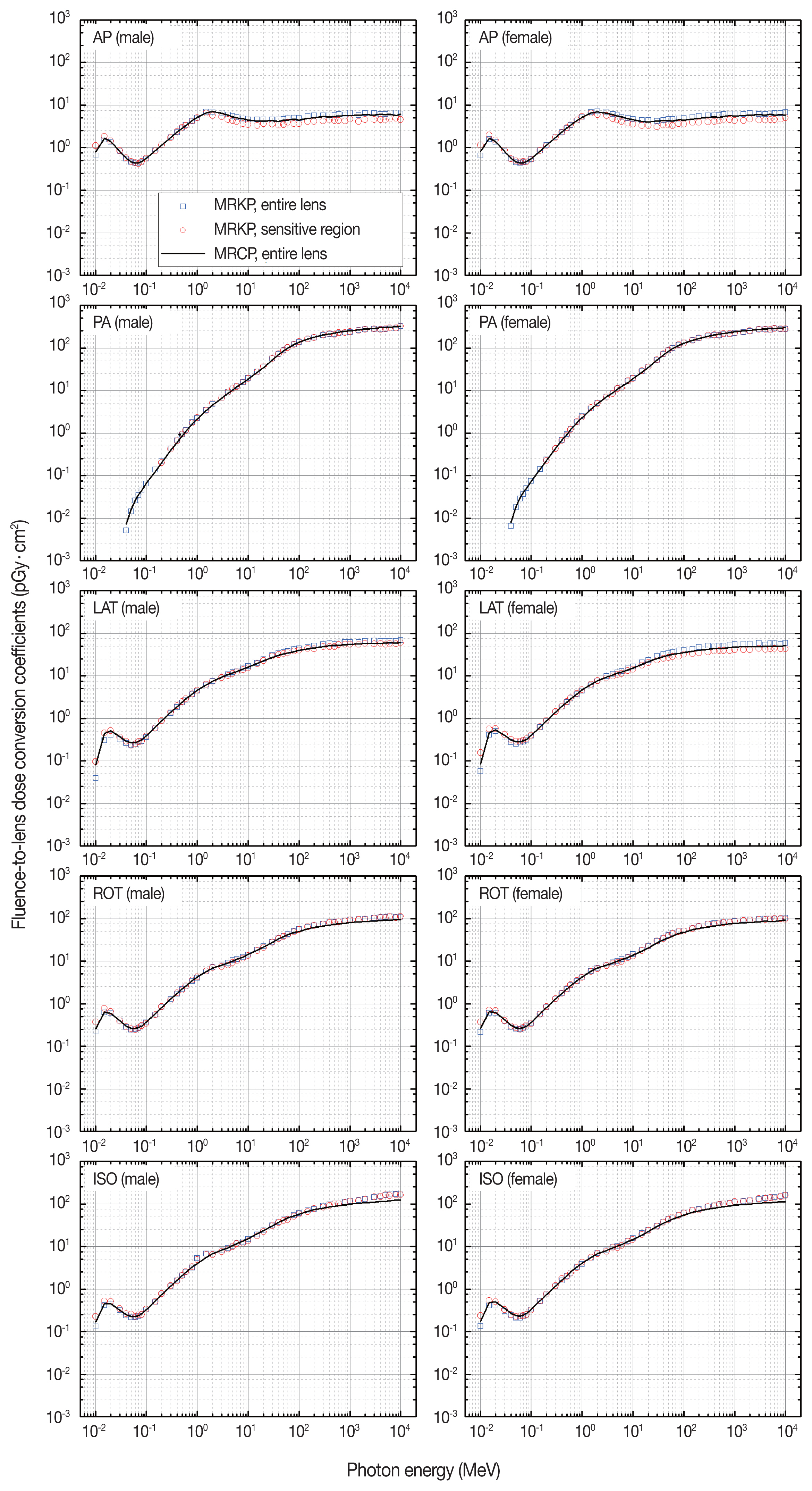
Lens doses per particle fluence (i.e., fluence-to-lens dose conversion coefficients) for photons in five idealized irradiation geometries (i.e., anteroposterior [AP], posteroanterior [PA], right lateral [RLAT], left lateral [LLAT], rotational [ROT], and isotropic [ISO]) of adult male (left) and female (right). MRCP, mesh-type reference computational phantom; MRKP, mesh-type reference Korean phantom.
Fig. 5 compares the lens doses of the entire lens calculated with the MRKPs and the MRCPs for electrons in three idealized irradiation geometries (i.e., AP, PA, and ISO). In all three irradiation geometries, it can be seen that the lens doses of the MRKPs tend to be close to those of the MRCPs, except for the energy range of 0.5–1 MeV in the AP and ISO geometries where significant differences were found between the lens doses of the MRKPs and the MRCPs. The differences were larger in the AP geometry than the ISO geometry, the maximum difference being a factor of about 10 at 0.6 MeV. Such large differences are due to the fact that the lens dose varies very sensitively to the depth of the lens in the energy range where primary electrons start to reach the lens.
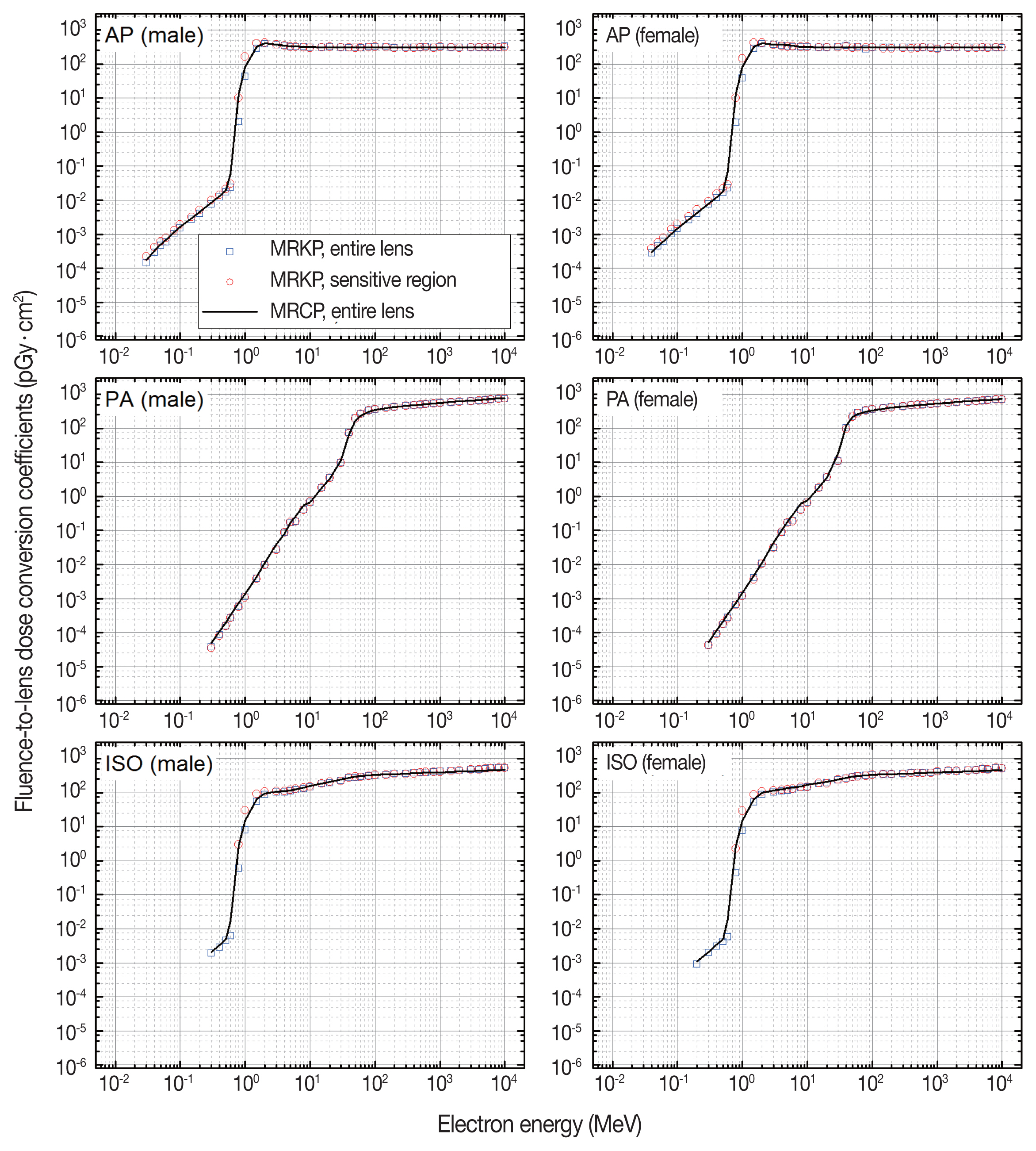
Lens doses per particle fluence (i.e., fluence-to-lens dose conversion coefficients) for electrons in three idealized irradiation geometries (i.e., anteroposterior [AP], posteroanterior [PA], and isotropic [ISO]) of adult male (left) and female (right). MRCP, mesh-type reference computational phantom; MRKP, mesh-type reference Korean phantom.
In the present study, for the MRKPs, the dose to the entire lens was compared with the dose to the sensitive region of the lens. For photons, at low energies less than approx. 1 MeV, the dose of the sensitive region was generally higher than that of the entire lens, maximum difference being approx. 2.7 times. At higher energies, on the other hand, the tendency was slightly inverted with the maximum difference of approx. 1.4, which is due to build-up effect. For electrons, the dose of the sensitive region of the eye lens for the MRKPs was significantly greater than that of the entire lens for the AP and ISO geometries in the energy range of 0.5–1 MeV, the maximum difference being approx. 5 times at 0.8 MeV in the AP geometry. This is due to the fact that the electrons in this energy range barely reach the anterior part of the lens, and thus deposit most of the energy to the anterior part of the lens where the sensitive region is located.
Conclusion
In the present study, a detailed eye model was developed for Korean adults. The developed eye model was then used to calculate lens doses for photons and electrons, which were compared with those calculated with the MRCPs to observe the effect of ethnic difference on lens dose. The result showed that the lens doses calculated with the ICRP MRKPs and the MRCPs were not much different for photons for the entire energy range considered in the present study. For electrons, the differences were generally small, but exceptionally large differences were found at a specific energy range (0.5–1 MeV), the maximum difference being about 10 times at 0.6 MeV in the AP geometry. Therefore, the MRCPs are generally considered acceptable for lens dose calculation for Korean population, except for the electrons at the energy range of 0.5–1 MeV for which it is suggested to use the MRKPs incorporating the Korean eye model developed in the present study.
Acknowledgements
This work was supported by the Nuclear Safety Research Development (NSR&D) Program through the Korea Foundation of Nuclear Safety (KoFONS) funded by the Nuclear Safety and Security Commission (NSSC) (No. 1705006), the National Research Foundation of Korea (NRF) grant funded by the Korea government (MSIT) (No. NRF-2017M2A8A4015258, NRF-2019M2D2A1A02059814), and the Korea Institute of Energy Technology Evaluation and Planning (KETEP) grant funded by the Korea government (MOTIE) (No. 20191510-301040). The authors (Han and Choi) were supported by the Global Ph.D. Fellowship program (No. NRF-2017H1A2-A1046391, NRF-2018H1A2A1059767). The author (Yeom) was supported by a grant of the Korean Health Technology R&D Project through the Korean Health Industry Development Institute (KHIDI), funded by the Ministry of Health & Welfare, Republic of Korea (No. H18C2257).
Notes
Conflict of Interest
No potential conflict of interest relevant to this article was reported.

